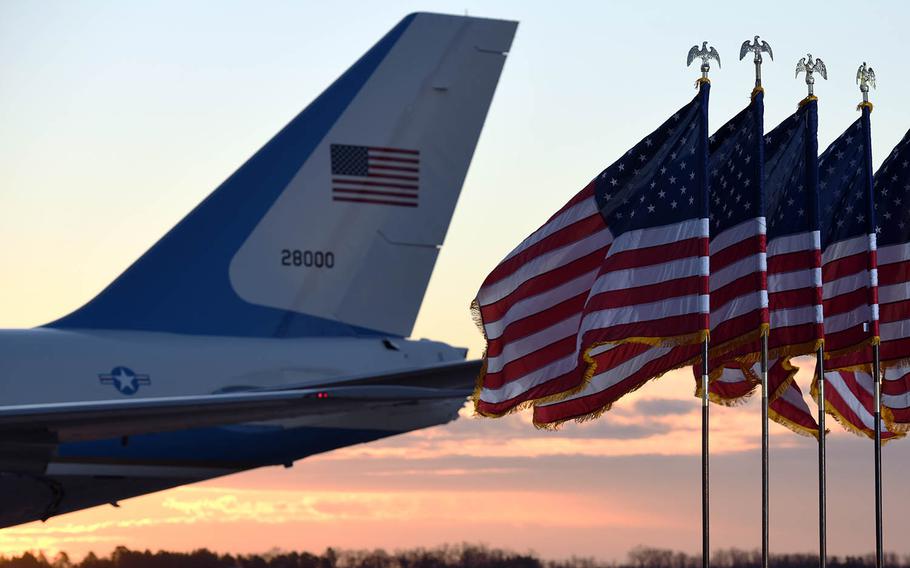
Air Force One parks on the flight line at Joint Base Andrews, Md., Jan. 20, 2021. (Logan Carlson/U.S. Air Force)
WASHINGTON — A civilian who entered Joint Base Andrews, the home of Air Force One, and accessed a military aircraft last month was improperly allowed onto the Maryland installation by a “distracted and complacent” airman guarding a gate, an Air Force Inspector General investigation concluded.
A Security Forces airman on Feb. 4 failed to ensure the civilian had proper credentials to enter Joint Base Andrews before granting him access to the installation, where hours later he accessed the flight line and boarded a C-40 transport aircraft, an IG report released Thursday determined. The airman’s mistake at Andrews’ southern Virginia Gate was the first in a series of critical security failures on post that ultimately resulted in the arrest of the man, who the Air Force has declined to name publicly.
“There were three layers of breakdowns,” Lt. Gen. Sami Said, the Air Force inspector general, told reporters Thursday. “The first one — the one that really should have stopped this ball from rolling in the first place is obviously the gate [where] we had a Security Forces airman — they were distracted and did not follow a procedure.”
The other security lapses would come hours later, when the intruder accessed the flight line via a broken gate and when Air Force personnel then failed to stop him from entering an airplane parked on the flight line, according to Said.
The gate guard, IG officials said, was fully qualified and trained to work at Joint Base Andrews’ four access points, which was a regular requirement of the individual’s job. The airman’s name is redacted from the IG report. The airman, who has faced undisclosed nonjudicial punishment from his command, told investigators that he was distracted by a personal issue that morning and had grown complacent while manning the gate.
The airman also told investigators that he was uncertain if he checked any credential — including a driver’s license that alone should not have permitted the individual access to the base — before allowing the intruder through the gate.
The civilian, who is described in the report as homeless with a lengthy arrest record, was permitted onto the installation just after 7:15 a.m. The individual briefly entered Joint Base Andrews’ Post Exchange before entering the flight line, near the post’s center, just after noon. The intruder, who was on foot, entered the flight line through an 18-inch gap left by a malfunctioning automatic gate meant to control access to the airfield from the 89th Airlift Wing’s passenger terminal, according to the IG.
Though personnel were present on the flight line, they did not see the intruder walk toward the C-40 Clipper parked there. The C-40 Clipper, which was open for crew training, is the military version of the Boeing 737-700C often used by U.S. officials and lawmakers. Two crewmembers training aboard the C-40 did not challenge the civilian’s presence, IG investigators wrote in the report. They watched the man enter the aircraft and exit within a few minutes.
The suspect was apprehended after leaving the aircraft by members of the 316th Security Forces Squadron, who had been alerted to the intruder’s presence by an Air Force official inside the passenger terminal, the IG said. The official had noticed the intruder was wearing “a bright red or pink cap that partially covered his ears and had distinctive balls on top that looked a little like mouse ears,” the investigative report said.
The man was arrested and transferred to local police officials on an outstanding warrant after questioning. The Air Force charged him with unauthorized access to the flight line.
Investigators determined the man was acting alone and had no intention to harm anyone nor was he carrying anything that could be used as a weapon. His name was not found on any terrorist watch lists.
“When we questioned him several times as to why he was there, his response was, ‘I just wanted to see airplanes,’ ” Said said.
The general declined to name the suspect, citing his civilian status.
The individual never came near any of the planes regularly used to transport the U.S. president, known as Air Force One when the commander-in-chief is aboard, Said told reporters. Those aircraft are housed on a different part of the flight line under much more stringent security measures, he said, declining to provide specifics about the upgraded security around aircraft used by the president.
"The Air Force One, those multiple airplanes ... was never, ever in question," Said said. "This individual got nowhere close to that area of the flight line. And we're 100% certain he could have never gotten close to that because the layers of security are orders of magnitude higher."
Since the Feb. 4 incident, Joint Base Andrews has tightened its security on post, Said said Thursday. Commanders at the base have added new security measures, fixed the flight line gate and added more roving security patrols, among other changes, which Said declined to make public, citing security concerns.
The IG investigation did not find systemic security issues at Joint Base Andrews that allowed the Feb. 4 security breach. However, the IG is also conducting an overall review of security at its Air Force bases around the globe, after the Andrews incident and other recent security failures at other locations.
That review began about two weeks ago, Said announced Thursday, and it will be months before the IG was prepared to release its findings.
That review is looking broadly at Air Force security techniques and procedures, training and other issues.
“They’re going back to look at any unauthorized intrusions over the last several years to see if there are any common themes or baseline issues,” Said said. “They're looking at it soup to nuts to go, ‘What are the factors across our installations that could cause us to fumble?’”